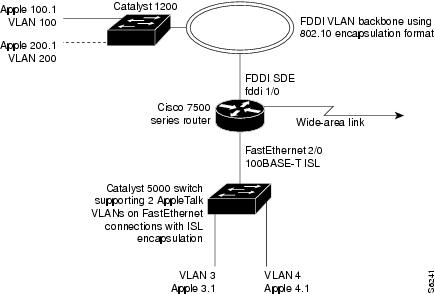 Feedback Feedback
|
Table Of Contents
Configuring Routing Between VLANs with IEEE 802.10 Encapsulation
Configuring AppleTalk Routing over IEEE 802.10
Configuring AppleTalk on the Subinterface
Defining the VLAN Encapsulation Format
Monitoring and Maintaining VLAN Subinterfaces
Routing AppleTalk over IEEE 802.10 Configuration Example
Configuring Routing Between VLANs with IEEE 802.10 Encapsulation
This chapter describes the required and optional tasks for configuring routing between VLANs with IEEE 802.10 encapsulation.
For a complete description of the commands in this chapter, refer to the the Cisco IOS Switching Services Command Reference. To locate documentation of other commands that appear in this chapter, use the command reference master index or search online.
To identify the hardware platform or software image information associated with a feature, use the Feature Navigator on Cisco.com to search for information about the feature or refer to the software release notes for a specific release. For more information, see the section "Identifying Supported Platforms" in the chapter "Using Cisco IOS Software."
The IEEE 802.10 standard provides a method for secure bridging of data across a shared backbone. It defines a single frame type known as the Secure Data Exchange (SDE), a MAC-layer frame with an IEEE 802.10 header inserted between the MAC header and the frame data. A well-known Logical Link Control Service Access Point notifies the switch of an incoming IEEE 802.10 frame. The VLAN ID is carried in the 4-byte security association identifier (SAID) field.
HDLC Serial links can be used as VLAN trunks in IEEE 802.10 VLANs to extend a virtual topology beyond a LAN backbone.
Configuring AppleTalk Routing over IEEE 802.10
AppleTalk can be routed over VLAN subinterfaces using the ISL or IEEE 802.10 VLANs feature that provides full-feature Cisco IOS software AppleTalk support on a per-VLAN basis, allowing standard AppleTalk capabilities to be configured on VLANs.
AppleTalk users can now configure consolidated VLAN routing over a single VLAN trunking interface. Prior to introduction of this feature, AppleTalk could be routed only on the main interface on a LAN port. If AppleTalk routing was disabled on the main interface or if the main interface was shut down, the entire physical interface would stop routing any AppleTalk packets. With this feature enabled, AppleTalk routing on subinterfaces will be unaffected by changes in the main interface with the main interface in the "no-shut" state.
To route AppleTalk over IEEE 802.10 between VLANs, create the environment in which it will be used by customizing the subinterface and perform the tasks described in the following sections in the order in which they appear:
•
Configuring AppleTalk on the Subinterface
•
Defining the VLAN Encapsulation Format
•
Monitoring and Maintaining VLAN Subinterfaces
Enabling AppleTalk Routing
To enable AppleTalk routing on IEEE 802.10 interfaces, use the following command in global configuration mode:
Router(config)# appletalk routing [eigrp router-number]
Enables AppleTalk routing globally.
Note
For more information on configuring AppleTalk, see the "Configuring AppleTalk" chapter in the Cisco IOS AppleTalk and Novell IPX Configuration Guide.
Configuring AppleTalk on the Subinterface
After you enable AppleTalk globally and define the encapsulation format, you need to enable it on the subinterface by specifying the cable range and naming the AppleTalk zone for each interface. To enable the AppleTalk protocol on the subinterface, use the following commands in interface configuration mode:
Defining the VLAN Encapsulation Format
To define the VLAN encapsulation format as either ISL or 802.10, use the following commands in interface configuration mode:
Monitoring and Maintaining VLAN Subinterfaces
To indicate whether a VLAN is a native VLAN, use the following command in privileged EXEC mode:
Routing AppleTalk over IEEE 802.10 Configuration Example
The configuration example shown in Figure 88 shows AppleTalk being routed between different ISL and IEEE 802.10 VLAN encapsulating subinterfaces.
Figure 88 Routing AppleTalk over VLAN encapsulations
As shown in Figure 88, AppleTalk traffic is routed to and from switched VLAN domains 3, 4, 100, and 200 to any other AppleTalk routing interface. This example shows a sample configuration file for the Cisco 7500 series router with the commands entered to configure the network shown in Figure 88.
Cisco 7500 Router Configuration
!interface Fddi 1/0.100encapsulation sde 100appletalk cable-range 100-100 100.2appletalk zone 100!interface Fddi 1/0.200encapsulation sde 200appletalk cable-range 200-200 200.2appletalk zone 200!interface FastEthernet 2/0.3encapsulation isl 3appletalk cable-range 3-3 3.2appletalk zone 3!interface FastEthernet 2/0.4encapsulation isl 4appletalk cable-range 4-4 4.2appletalk zone 4!

